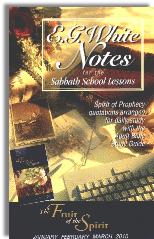|
||||||||||||||
Commentary on "The Fruit of the Spirit is Love"
Day 2: Sunday, January 3, 2010
Overview
“Jesus said to him, ‘You shall love the Lord your God with all your heart, with all your soul, and with all your mind. This is the first and great commandment. And the second is like it: You shall love your neighbor as yourself ’ ” (Matt. 22:37–39, NKJV; see also Deut. 6:5).
Observations
This is the most succinct definition of the Old Covenant ever given. God had given the Israelites this definition very early on, but it took Jesus to tie the two statements in Deuteronomy and Leviticus together in answer to the question, “Which is the greatest commandment of the Law?” He quoted Deuteronomy 6:5 and Leviticus 19:18 as one command.
Notice the implied emphasis in both commands. YOU love God with your entire being. YOU love your neighbor as yourself.
This was the extent of the Old Covenant. Does this make the Old somehow unimportant or flawed? Of course not. “So then, the law is holy, and the commandment is holy, righteous and good (Romans 7:12). But the Old Covenant was preparatory, not final. It has completed its work when a person realizes that he or she never can measure up to the demands of the Law, and then turns to Jesus for new life.
Jesus Himself defined the difference between the Old and New Covenants. “Then they asked him, ‘What must we do to do the works God requires?’ Jesus answered, ‘The work of God is this: to believe in the one he has sent’ ” (John 6:28-29). “My command is this: Love each other as I have loved you” (John 15:12).
Under the Old Covenant, God gave Israel the Law (every aspect of it) as a representation of what He was like. Under the New Covenant, we have been given Jesus, God Incarnate. This changes everything. We no longer try to figure out how to love the God “out there” or to love our neighbors as ourselves (knowing as we do that “loath” probably is the better word). Instead, God is “in here” in the person of the Holy Spirit, and the Spirit’s primary job is to point us to Jesus, always and only Jesus.
When we fix our eyes on Jesus as the Author and Perfecter of our faith, then we are changed from the inside out, and His love now has a chance of flowing through us to others.
The lesson quarterly leaves it unfinished, leaves it in the Old Covenant: “He [Jesus] is saying, ‘You need to love God with your entire being.’ ”
Summary
- Jesus was born under the Old Covenant (see Galatians 4:4-5). As such, one of His roles was to point out exactly what being under Law meant. This is why He answered the question as He did by perfectly summarizing the Old Covenant.
- But Jesus had an even more important role—to usher in the New Covenant. He did so by His death on the cross, and He provided the means for living within this New Covenant by His resurrection. This is why Jesus commanded that we believe in Him and to love as we have been loved.
- Quoting only Jesus’ first explanation leaves the reader with an incomplete and completely inadequate idea of what it means to love.
GO TO DAY 3
Copyright 2010 BibleStudiesForAdventists.com. All rights reserved. Revised January 1, 2010. This website is published by Life Assurance Ministries, Glendale, Arizona, USA, the publisher of Proclamation! Magazine. Contact email: BibleStudiesForAdventists@gmail.com.
The Sabbath School Bible Study Guide and the corresponding E.G. White Notes are published by Pacific Press Publishing Association, which is owned and operated by the Seventh-day Adventist church. The current quarter's editions are pictured above.
Official Adventist Resources
Standard Edition Study Guide Week 2
Teacher's Edition Study Guide Week 2
Easy Reading Edition Study Guide Week 2
Search the Complete Published Ellen G. White Writings


